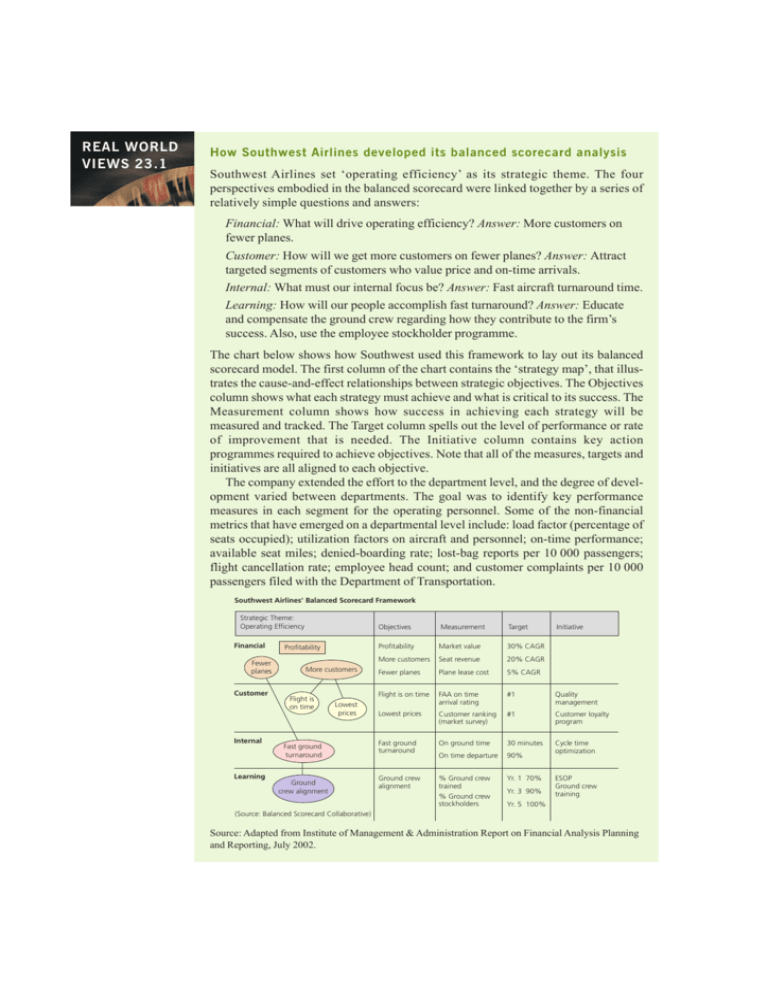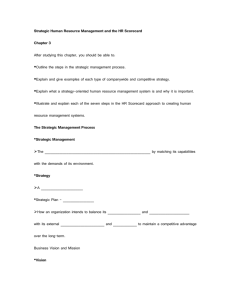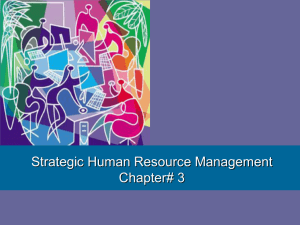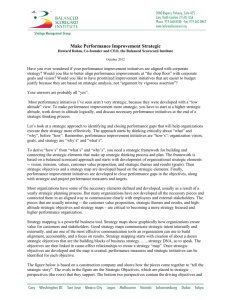How Southwest Airlines developed its balanced scorecard analysis
advertisement

REAL WORLD VIEWS 23.1 How Southwest Airlines developed its balanced scorecard analysis Southwest Airlines set ‘operating efficiency’ as its strategic theme. The four perspectives embodied in the balanced scorecard were linked together by a series of relatively simple questions and answers: Financial: What will drive operating efficiency? Answer: More customers on fewer planes. Customer: How will we get more customers on fewer planes? Answer: Attract targeted segments of customers who value price and on-time arrivals. Internal: What must our internal focus be? Answer: Fast aircraft turnaround time. Learning: How will our people accomplish fast turnaround? Answer: Educate and compensate the ground crew regarding how they contribute to the firm’s success. Also, use the employee stockholder programme. The chart below shows how Southwest used this framework to lay out its balanced scorecard model. The first column of the chart contains the ‘strategy map’, that illustrates the cause-and-effect relationships between strategic objectives. The Objectives column shows what each strategy must achieve and what is critical to its success. The Measurement column shows how success in achieving each strategy will be measured and tracked. The Target column spells out the level of performance or rate of improvement that is needed. The Initiative column contains key action programmes required to achieve objectives. Note that all of the measures, targets and initiatives are all aligned to each objective. The company extended the effort to the department level, and the degree of development varied between departments. The goal was to identify key performance measures in each segment for the operating personnel. Some of the non-financial metrics that have emerged on a departmental level include: load factor (percentage of seats occupied); utilization factors on aircraft and personnel; on-time performance; available seat miles; denied-boarding rate; lost-bag reports per 10 000 passengers; flight cancellation rate; employee head count; and customer complaints per 10 000 passengers filed with the Department of Transportation. Southwest Airlines' Balanced Scorecard Framework Strategic Theme: Operating Efficiency Financial Fewer planes Customer Internal Learning Profitability More customers Flight is on time Lowest prices Fast ground turnaround Ground crew alignment Objectives Measurement Target Profitability Market value 30% CAGR More customers Seat revenue 20% CAGR Fewer planes Plane lease cost 5% CAGR Flight is on time FAA on time arrival rating #1 Quality management Lowest prices Customer ranking (market survey) #1 Customer loyalty program Fast ground turnaround On ground time 30 minutes On time departure 90% Cycle time optimization Ground crew alignment % Ground crew trained % Ground crew stockholders Yr. 1 70% Yr. 3 90% Initiative ESOP Ground crew training Yr. 5 100% (Source: Balanced Scorecard Collaborative) Source: Adapted from Institute of Management & Administration Report on Financial Analysis Planning and Reporting, July 2002.









